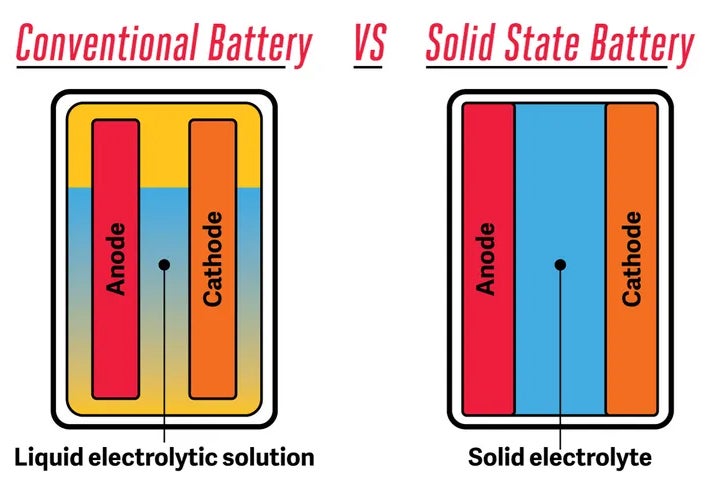The internal combustion engine (ICE) is one of the most revolutionary modern inventions. After millennia of transport by horse-drawn carriages, people all around the world embraced the self-powered automobile. Early car companies were met with the challenge of producing these vehicles on a large scale, but when Henry Ford created fast and affordable assembly lines, their popularity skyrocketed. Today, implementing electric cars is a similar challenge, with a major obstacle being the efficiency of their batteries. Electric cars are still not as powerful as their ICE-powered predecessors, but the invention of solid-state batteries could be the push they need to dominate the market.
Lithium-Ion: The Crown Joules of Batteries
Lithium-ion batteries are the most ubiquitous in the world today, powering everything from phones to cars. They themselves were a cutting-edge innovation once, offering a rechargeable alternative to single-use batteries. A typical example of a lithium-ion battery contains two electrodes and an electrolyte. One electrode is positively charged and called a cathode, while the other is negatively charged and called an anode. Power is discharged when electrons, negatively charged subatomic particles, move from the anode to the cathode. In the case of lithium-ion batteries, the electrolyte is a liquid containing lithium ions, which also move from the anode to the cathode. When recharging, lithium ions and electrons move from the cathode back to the anode, allowing them to drain again later. Solid-state batteries differ in that their electrolyte is a solid instead of a liquid, which has the possibility to remedy the major drawbacks of lithium-ion batteries.

Corrosive Complications
As revolutionary as lithium-ion batteries were, technological developments have pushed this remarkable invention to its limits. The presence of acidic electrolyte fluid in the batteries can become a safety risk. Under conditions such as hot weather, lithium-ion batteries can spontaneously start a chemical fire that is incredibly difficult to control. They can also swell or leak their electrolyte fluid when damaged, which can ruin the devices they’re used in and endanger people’s health. In contrast, the presence of a solid electrolyte in solid-state batteries would severely mitigate these risks.
The Current of Progress
In addition to the improved safety features, solid-state batteries offer numerous other improvements to lithium-ion batteries. Electric vehicles are currently still impractical for long-distance travel due to the low capacity of their batteries and how long it takes for them to charge, but solid-state batteries are much faster to charge and can retain their energy for a longer period of time. QuantumScape, a company developing this technology, claims that solid-state batteries will boost driving range by 50 to 80 per cent and take only 15 minutes to charge to 80 per cent capacity. Recent experiments also indicate that they could have a lifetime of 10 to 15 years without needing to be replaced, a significant increase from the 8-year lifespan of current electric vehicles. This can radically transform the automobile industry, as electric power is far more likely to overtake the combustion engine if its vehicles have similar lifetimes, mileages, and convenience.
Fuse for Thought
Research into solid-state batteries is still in its infancy and the technology is still not stable enough for commercial distribution, a topic which remains an ongoing debate in the scientific community. While certain car manufacturers, such as Toyota, expect solid-state battery-powered cars to be available in 2025, some scientists believe that even 2030 is too optimistic an estimate. While some companies have embraced research into solid-state batteries, others, including Tesla, still invest their efforts in enhancing existing lithium-ion batteries, making the future difficult to predict.
After a century of relying on internal combustion engines, transitioning to battery power is an ambitious goal. For such a dramatic change to take place, electric vehicles need to be at least as efficient and affordable as gas-powered cars, and solid-state batteries give us a glimpse into that reality. However, where some see a breakthrough, others see false hope, claiming that improving existing batteries is more realistic than implementing new ones. Right now, the only certainty is that the automobile industry will be dramatically transformed in the years to come.
References:
https://pubs.rsc.org/en/content/articlepdf/2018/ee/c8ee01053f
https://www.tuev-nord.de/explore/en/remembers/a-brief-history-of-the-internal-combustion-engine/
Lithium Ion Battery - History - Accelerating Microscopy (thermofisher.com)
How does a lithium-Ion battery work? | Let's Talk Science (letstalkscience.ca)
What is a Solid-state Battery? (samsungsdi.com)
https://insideevs.com/news/443450/ex-tesla-solid-state-batteries-false-hope/




